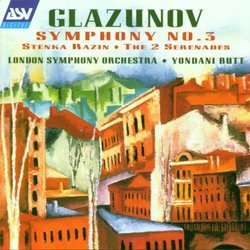| All Artists: Glazunov, Butt, Lso Title: Symphony 3 / Stenka Razin Members Wishing: 0 Total Copies: 0 Label: Asv Living Era Release Date: 8/23/1994 Genre: Classical Styles: Forms & Genres, Serenades & Divertimentos, Theatrical, Incidental & Program Music, Symphonies Number of Discs: 1 SwapaCD Credits: 1 UPC: 743625090321 |
Search - Glazunov, Butt, Lso :: Symphony 3 / Stenka Razin
 | Glazunov, Butt, Lso Symphony 3 / Stenka Razin Genre: Classical
|
Larger Image |
CD Details |
CD ReviewsA symphony of warmth & poetry with a semi-passionate playing David A. Hollingsworth | Washington, DC USA | 07/27/1999 (5 out of 5 stars) "By the time Alexander Konstantinovich Glazunov (1865-1936) wrote his Third Symphony by 1892, his reputation as among the leading composers of Russia & abroad continued to be established. In most ways, the symphony represented the departure to the orientalism of the Russian Five that Glazunov was deeply influenced under: the orientalism which cast the spell on works between 1879 and 1891 such as, for examples, the serenades, his first two symphonies, symphonic Poems "The Sea", "The Forest", The Kremlin", and "Stenka Razin" as well as the Oriental Rhapsody, String Quartets 1,2,&3, Suite for String Quartet as well as Five Pieces & Five Novellettes for String Quartet. Needless to say, Glazunov's early piano works such as the Three Etudes & the Suite "Sacha" were also under the sway of the orientalism so much advogated by Mily Balakirev & his group. Thus the Third Symphony represent the turning point of Glazunov's musical language & expressionism. The lyricism, always present in all of Glazunov's scores before this work, points more towards Tchaikovsky (the dedicatee of the symphony incidentally). Not surprisingly perhaps, Glazunov had the most difficulties with the Third Symphony (more than any other works he has composed before & after it, including "Raymonda", his first of three ballets of 1897). He started sketching the work by 1892 & struggled immensely with the musical ideas for the next three years (even to the point of his former teacher & lifelong friend Nikolay Rimsky-Korsakov giving Glazunov a scolding). The result is a work of confidence, beauty, charm, a "Doctor Zhivago" like poetry. It has little adventurous writings of the Second Symphony, but the work is appealing nevertheless. Whereas the First movement is poetic & optimistic, the Scherzo movement is especially sparkling while the Andante is peaceful & heart-warming. The finale, though well constructed, is too developmental & recapulative (Glazunov's chief weakness in constructing symphonies). Otherwise, the symphony is attractive and hardly disappointing.The other works on the disc demonstrates the orientalism & the nationalism of the Russian Five. Whereas the two serenades (essentially miniatures) has the youthful charm & some of the virtuosity, "Stenka Razin" is purely dynamic and nationalistic, with a popular folksong "Song of the Volga Boatman" embetted throughout. It is an ingenius work (and an important one, with its premiere with the Second Symphony @ the 1889 Paris Exhibition). The London Symphony & the Royal Philharmonic Orchetras under Yodani Butt performed with warmth & commitment. They lacked the passion that you will find in Svetlanov's USSR State Symphony Orchestra or Rozhdestvensky's USSR Ministry of Culture Symphony Orchestra (recorded originally by Melodiya. The general misconception of Glazunov was (and still is) that he wrote music with very little passion and emotionalism. However, Glazunov had passion and it is important that ensembles performed not under the misconception, but under the acknowledgement of a man proud of his motherland, as Glazunov so effectively demonstrated throughout his entire year. Ensembles should try in earnest to share the passion, as did the aforementioned Russian orchestras or the Scottish National Orchestra in Glazunov's shorter orcheatral works (like "Stenka Razin"). I personally will not be tempted to invest in the Naxos series of Glazunov's works: the performances lacked the necessary Russian passion & sonority under conductors with a not a firm hand & refinement. The strings & winds sound thinnish whereas Soviet orchestras sounded full & exciting, full-bodied Russian poetry no one needs apologies for. For Stenka Razin, try Neemi Jarvi & the Scottish National Orchestra (so far the best recording currently available). For Glazunov's Third Symphony, this recording will have to do, at least until Svetlanov's and/or Rozhdestvensky recordings will be re-issued (which may be a long-shot due to BMG's control over the rights of Melodiya recordings since late 1992). Keep your fingers cross. Otherwise, recommendable, though not a first choice (for me anyways)." Convincing accounts G.D. | Norway | 04/30/2009 (4 out of 5 stars) "Compared to other recordings of this work, Butt's approach is rather easy-going and generally light - it is not without emotion or passion, but does, perhaps, lack the urgency and intensity of Rozhdestvensky, say. Yet the opening with the pounding winds underpinning the beautiful, soaring string melody is finely captured and the Andante is atmospheric with the exact right amount of Russian nostalgia. The Scherzo is another of those truly memorable Glazunov creations and is well-played here, but not even this performance completely manages to save the overlong finale. Overall, a very competitive account, though lacking that last ounce of white-hot energy in the outer movements the symphony needs in order fully to convince.
The couplings include the symphonic poem Stenka Razin - at one time perhaps Glazunov's most famous work - an exhilarating, superbly scored, dramatic work - huge fun, in other words, though relying more on flashy firework tactics than genuine substance;, but it does include some truly memorable moments such as the secondary string theme. The two serenades are light and attractive but hardly great music composed in Glazunov's teens; there are some nice tunes here, and they are well worth hearing, though. The playing is generally good in these other works as well, and the sound quality, though a little boomy and rough, is generally more than acceptable." |

 Track Listings (7) - Disc #1
Track Listings (7) - Disc #1